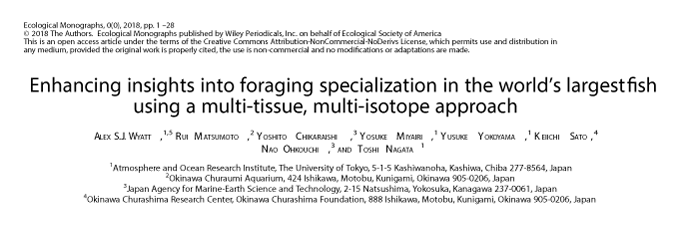Enhancing insights into foraging specialization in the world’s largest fish using a multi-tissue, multi-isotope approach
Alex S.J. Wyatt1*, Rui Matsumoto2, Yoshito Chikaraishi3, Yosuke Miyairi1, Yusuke Yokoyama1, Keiichi Sato4, Nao Ohkouchi3, Toshi Nagata1
1Atmosphere and Ocean Research Institute, The University of Tokyo, Kashiwa, Chiba, Japan. 2Okinawa Churaumi Aquarium, Motobu, Okinawa, Japan. 3Japan Agency for Marine-Earth Science and Technology, Yokosuka, Japan. 4Okinawa Churashima Research Center, Okinawa Churashima Foundation, Motobu, Okinawa, Japan.
Intra-species variability in foraging strategies may be common, which has significant implications for efforts to understand and manage enigmatic species like the whale shark Rhincodon typus. The ecological relevance of differences in tissue isotopes within and between individuals in the context of foraging however depends on understanding tissue turnover times and carbon (Δ13C) and nitrogen (Δ15N) discrimination, which can vary with physiology, metabolism and diet quality. Here we examine isotope dynamics in captive R. typus as a basis for enhanced ecological insights into wild populations of the world’s largest fish and other enigmatic species. A variable diet, principally consisting of two krill (Euphausia pacifica and E. superba) provided an average of 48 MJ d-1 (± 20 S.D.), or 2.7 times (± 1.3) basal metabolic requirements. On this diet, in agreement with allometric relationships, large body sizes (3,000 to 4,000 kg) were matched by slow plasma and cartilage turnover rates (empirically derived as 9 months and 3 years, respectively), which provide tissue-specific limits on the time-scales over which we can isotopically detect changes in diet in this species. Average diet-to-tissue discrimination showed significant variation between tissues (plasma and cartilage), and among growing and fasting individuals (Δ13C range: 1.5 – 5.5 ‰; Δ15N range: −0.1 – 2.9 ‰). Assimilation rates increased with temperature and were higher for the smaller E. pacifica (15 ± 2 mm) than E. superba (48 ± 2 mm). Growth significantly lowered both Δ15Nplasma and Δ15Ncartilage, with inappetence markedly reducing Δ15Nplasma and Δ13Cplasma, as well as significantly altering blood biochemistry. Captive findings facilitated the first robust multi-tissue growth- and nutrition-corrected isotope analysis of a wild R. typus population, suggesting individual foraging specialization on low trophic level mid-ocean or coastal prey. Long-term fasting during ocean-basin scale migrations may be common and such metabolic effects should be carefully quantified when isotopically assessing intra-species foraging differences. The metabolically-constrained multi-tissue, multi-isotope approach described can facilitate ecological insights that are indispensable for effective conservation and management of globally threatened, but poorly understood, species by identifying differences in key foraging areas and target prey within and between individuals.

